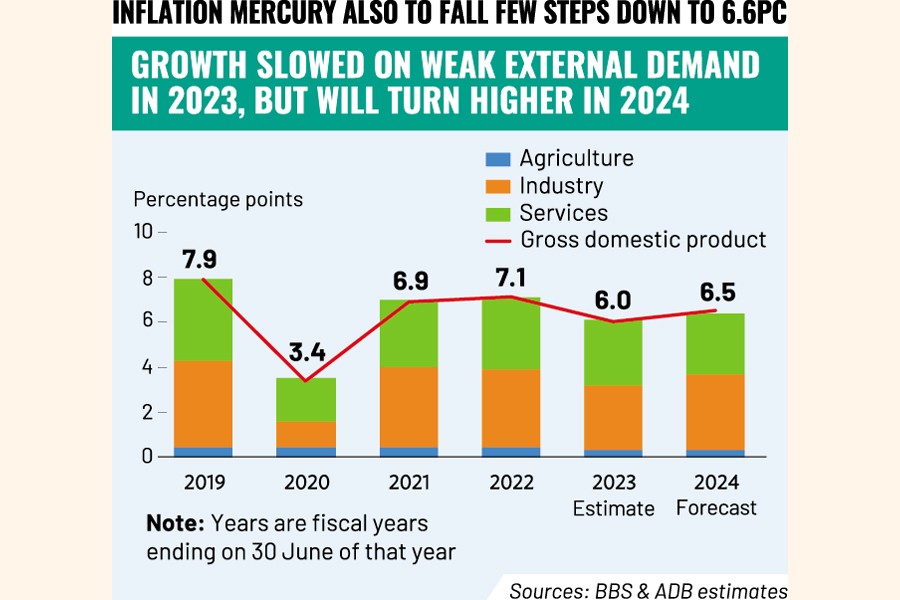
Bangladesh's economy may perform little better than envisaged earlier by the Asian Development Bank as it looks up to 6.5-percent GDP growth this fiscal with its cushioning effect on inflation.
The latest Asian Development Outlook (ADO) prepared by the ADB forecasts that the Inflation mercury is likely to fall few steps down to 6.6-percent bracket in tune with the economic recovery.
In its updated outlook the Asian bank puts the country's gross domestic product (GDP) growth projection for the financial year 2023-24 at 6.5 per cent with an increase by 0.5 percentage points in FY2023, due to a steady export growth supported by economic recovery in the euro zone.
The ADB also sees some downside risks, such as effects of any adverse weather events and further deterioration in the balance-of-payments situation, if global demand gets weaker than expected.
The inflation, which stayed on average over 9.8 per cent during the past two months of the current fiscal year, is projected to decline to 6.6 per cent in FY2024 attune with projected economic improvements.
"Though high inflation may persist in the first months of the fiscal year, it is expected that it will come down with some fall in global nonfuel commodity prices, expected higher agricultural production, and the initial tightening of monetary policy under the new framework," the ADO reads.
Bangladesh's imports remained tightened since the beginning of the fiscal year 2023 under an austerity recipe to tide over a foreign-exchange crunch amid global economic volatility. However, the ADB expects import growth to return into positive territory due to an increase in demand for export-related intermediates and government imports.
It predicts that the trade may grow 7.0 per cent with an increase in import demand for intermediates and capital goods to cater economic expansion.
On consumption side of the economy, the ADB says: "Moderate inflation and an increase in remittances will contribute to reviving private consumption, alongside completion of a number of major government infrastructures."
On the supply side, industry is expected to contribute most to growth.
Agriculture-sector growth is projected to increase to 2.9 per cent in FY2024 on assumption of normal weather and government policy supports including distribution of quality seeds, fertilisers, and training to farmers.
The ADO forecasts growth in industry to rise to 9.3 per cent in FY2024, driven by improvement in power supply and better access to imports. However, growth in the service sector is expected to be slower at 5.5 per cent, with expected lower growth in real estate and human health and social-work activities.
Export growth is projected to slightly accelerate to 9.0 per cent.
The trade deficit is forecast to slightly widen to $17.3 billion in FY2024 as the increase in imports surpasses that of exports in nominal terms.
Remittance growth will accelerate to 8.4 per cent as a market-driven exchange rate and cash incentives are expected to encourage increased transfer through official channels.
Monetary policy is expected to be tightened. It will feature a transition from a monetary-aggregate- targeting framework to an interest-rate-targeting framework.
Bangladesh Bank has increased the policy interest rate from 6.0 per cent to 6.5 per cent accompanied by a symmetric corridor of 200 basis points for the standing loan and deposit facilities.
The central bank also replaced the cap on lending rate with a market-driven lending-rate regime for bank loans based on a reference lending rate called SMART (6-month moving average rate of treasury bills).
In FY2024, applicable lending rates will be SMART-plus a margin of up to 3.0 per cent for banks, and SMART-plus a margin of up to 5.0 per cent for nonbank financial institutions.
Loans to cottage, micro, small, and midsize enterprises and consumers could be charged an additional fee of up to 1.0 percentage points on top of the above-mentioned margin to cover supervision costs.
Bangladesh Bank is also adopting a single market-driven exchange rate and calculating gross foreign- exchange reserves in accordance with the sixth edition of the International Monetary Fund's Balance of Payments and International Investment Position Manual.
The development financier terms government's FY2024 budget "ambitious", in the current context, and cites its features. It aims to achieve a ratio of revenue to GDP at 10.0 per cent and of expenditure to GDP at 15.2 per cent with a resulting fiscal deficit of 5.2 per cent of the GDP, marginally higher than FY2023 revised budget target of 5.1 per cent.
"The policy is directed at slimming current expenditure and expanding capital expenditure. It is expected that 60.0 per cent of the deficit will be financed domestically: 85.2 per cent from banks and the remaining 14.8 per cent from nonbank sources, mostly the sale of national saving certificates," the ADB says.
The government is "managing relatively well against the external economic uncertainties while advancing infrastructure development and critical reforms to improve investment climate," said ADB Country Director for Bangladesh Edimon Ginting in their latest overall evaluation of Bangladesh situation.
"These key structural reforms include strengthening public financial management, enhancing domestic resource mobilisation, improving logistics, and deepening financial sector, which are critical for private- sector development, export diversification and productive job creation in the medium term," Mr Ginting added.
"Continued high oil prices also provide a good incentive to accelerate reforms to expand domestic renewable energy supply and achieve the country's climate change goals," the ADB country chief notes about a blessing in disguise from the fuel front.
jasimharoon@yahoo.com
© 2025 - All Rights with The Financial Express
